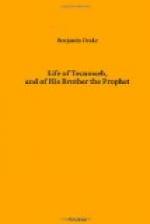“When I was first appointed governor of Indiana territory, these once powerful tribes were reduced to about thirty warriors, of whom twenty-five were Kaskaskias, four Peorians, and a single Michiganian. There was an individual lately alive at St. Louis, who saw the enumeration made of them by the Jesuits in the year 1745, making the number of their warriors four thousand. A furious war between them and the Sacs and Kickapoos, reduced them to that miserable remnant, which had taken refuge amongst the white people of the towns of Kaskaskias and St. Genevieve. The Kickapoos had fixed their principal village at Peoria, upon the south bank of the Illinois river, while the Sacs remained masters of the country to the north.
“During the war of our Revolution, the Miamis had invited the Kickapoos into their country to assist them against the whites, and a considerable village was formed by that tribe on Vermillion river, near its junction with the Wabash. After the treaty of Greenville, the Delawares had, with the approbation of the Miamis, removed from the mouth of the Auglaize to the head waters of White river, a large branch of the Wabash—and the Potawatamies, without their consent, had formed two villages upon the latter river, one at Tippecanoe, and the other at Chippoy, twenty-five miles below.
“The Piankishaws lived in the neighborhood of Vincennes, which was their ancient village, and claimed the lands to the mouth of the Wabash, and to the north and west as far as the Kaskaskias claimed. Such was the situation of the tribes, when I received instructions from President Jefferson, shortly after his first election, to make efforts for extinguishing the Indian claims upon the Ohio, below the mouth of the Kentucky river, and to such other tracts as were necessary to connect and consolidate our settlements. It was at once determined, that the community of interests in the lands amongst the Indian tribes, which seemed to be recognized by the treaty of Greenville, should be objected to; and that each individual tribe should




